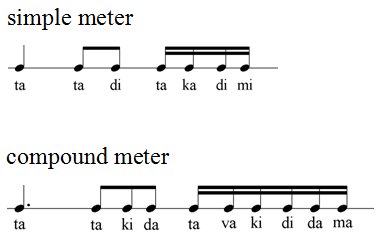
|
Society for Music Teacher Education

Tools for Teaching Music Literacy: Takadimi
Takadimi, similar to solfege, is a system of syllables used to read rhythms. The Takadimi syllables are organized around the beat. Each beat is indicated by the syllable ta, with the syllable di used at the beat mid-point. Syllables are assigned for each division and subdivision of the beat with different syllable sets for simple and compound meter: 
These symbols are learned in common beat-length patterns for easy recall and performance. The Short Guide (Hoffman, 2009) provides a detailed illustration of the varied Takadimi syllables in short rhythm patterns. Takadimi was developed by Richard Hoffman, William Pelto, and John W. White as part of a rhythm pedagogy program designed for college-level sight-singing and theory classes. This system "is simple enough for the prenotational stages of first-year courses but comprehensive enough to address the complexities of recent musical styles including polyrhythm, polymeter, and asymmetric divisions" (Hoffman, Pelto, & White, 1996, p.14). The Takadimi system joins a number of beat-based rhythm reading methods including those developed by Zolta Kodály (Chosky, 1998), Edwin Gordon (2003), and Allen McHose and Ruth Tibbs (1947). The system helps the learner identify and label sounds aurally and verbally with subsequent application to reading. Students work with rhythms in short common patterns rather than individual sounds. Takadimi supports the music literacy sound-to-sight connection (Gagné, 1977; Gordon, 2003; Ester, Scheib, & Inks (2006). This process begins with aurally and verbally identifying rhythmic sounds and then includes visual recognition translating into reading and writing rhythm. Takadimi was originally introduced in the mid 1990s at Ithaca College and is now being used at all levels of music instruction including P-12. It is the basis for elementary general music rhythm training used by Micheal Houlahan and Philip Tacka (2008). These two authors use Takadimi, with slight variations, to assist children to hear and identify where a specific note is located within the beat. They state: While the Kodály rhythm syllables have been effective in elementary school teaching, they have not been widely adopted by middle school teachers, high school teachers, or college instructors. Finding a system of rhythm syllables that can be used by music specialists at all levels of instruction that can be correlated with counting using numbers is necessary for consistency. The ta ka di mi system of rhythm pedagogy provides this link (p 120).Elementary music instruction is a logical place to begin Takadimi instruction. Rhythm is one of the most fundamental elements in childhood musical development. The child's natural rhythmic response can be easily channeled into experiences with music that include performing, moving, reading and writing, and improvisation. Takadimi with its sound-to-symbol process is an effective learning tool in this learning process because it can be applied to all early rhythmic notational study (Ester, et al, 2006). Takadimi is also effective for middle and high school instrumental and choral programs. Because the system indicates each beat with the syllable ta, it can provide for a smooth transition to the traditional beat counting method. Within these ensembles, initial Takadimi instruction and practice can pay large dividends of actual note reading verses rote training. Instructional materials using Takadimi are readily available. Carol Krueger uses the system as the rhythmic reading process in Progressive Sight Singing (2010). Training begins with hearing and imitating patterns and subsequently moves to reading and writing music notation. Todd Isler includes Takadimi reading techniques in You Can Ta Ka Di Mi This! (2005). The book and companion compact disc provide study exercises for the instrumentalist to help him/her establish and support rhythm reading and then apply what has been learned to any instrument. The Takadimi website Takadimi.net (2011) provides a wealth of information including teaching ideas and materials. Cited Works
Choksy, L. The Kodály Method I (3rd ed.). Prentice Hall, 1998.
Ester, D. P., Scheib, J. W., & Inks, K.J. (2006). Takadimi: A rhythm system for all ages.
Music Educators Journal, Vol. 93, No. 2, 60-65.
Gagné, R. Conditions of Learning (3rd ed.). New York: Holt, Rinehart, and Winston,
1977.
Gordon, E. E. Learning Sequences in Music. Chicago: GIA Publications, 2003.
Hoffman, P. (2009). The short guide.
www.takadimi.net/shortGuide.html.
Hoffman, R., Pelto, W., & White, J.W. (1996). Takadimi: A beat-oriented system of
rhythm pedagogy. Journal of Music Theory Pedagogy, V10. Takadimi.net.
Houlahan, M. & Tacka, P. Kodály Today: A Cognitive Approach to Elementary Music
Education. New York: Oxford University Press, 2008.
Isler, T. You Can Ta Ka Di Mi This! Brooklyn NY: Gerard and Sarzin Publishing Company,
2005.
Krueger, C. Progressive Sight Singing (2nd ed.). New York: Oxford University Press,
2010.
McHose, A., Tibbs, R. Sight-Singing Manual (4th ed.). New York: F. S. Crofts & Co.,
1947.
Takadimi.net, 2011.
Return to top |
|

